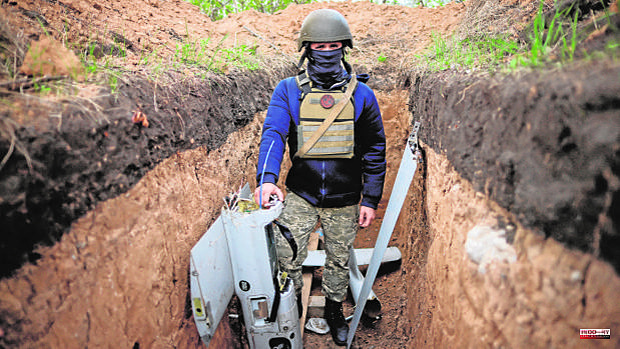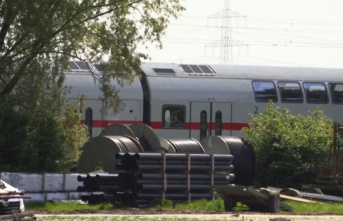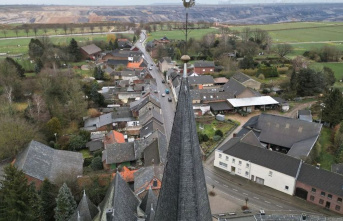The war in Ukraine is also about drones or, what is the same, remotely manned planes that launch missiles, take images so that artillery can set targets or directly crash into a target with their load of explosives. All this, guided from a comfortable cabin to tens or hundreds of kilometers, depending on its technology.
But in this military facet, the Ukraine war is far from American sophistication with General Atomics' Predators, Boeing's ScanEagles and AeroVironment's Ravens. Instead, a new major drone manufacturer (Turkish company Baykar) has been consolidated, and quite a bit of ingenuity has been shown on the Ukrainian side to adapt all sorts of small drones – commercial or military – for use on the battlefield.
On the Russian side, its army had more than 2,000 drones before the start of the war, compared to 180 in 2011, with the medium-sized Orlan-10 as the most numerous model in its arsenal. Although there is a feeling that Russia has also lagged behind in this technology.
But let's start with the drone most feared by Russian troops and a true sensation of the Ukrainian resistance: the Bayraktar TB2, a Turkish device specialized in launching missiles that has proven its worth in attacks on Russian tanks and convoys, artillery pieces and Russian navy ships near Snake Island.
This unmanned aircraft, with a flight range of 27 hours, even intervened in a diversionary maneuver for the daring mission that killed the Moskva missile cruiser, the flagship of the Russian Navy. Two of these devices distracted the ship's radars, which were eventually hit by Neptune anti-ship cruise missiles. Quite a symbol of the war in Ukraine.
Bayraktar TB2's exploits have even earned him a song with catchy lyrics that begins like this:
"The occupiers came to us in Ukraine/ with their new uniforms, military vehicles/ but their equipment melted a little/ Bayraktar... Bayraktar."
This Turkish-made drone in the service of the Ukrainian armed forces has a wingspan of 12 meters, length of 6.5 m. and a flight ceiling of 8,200 meters. Like all drones in its class, it is piloted remotely from a cockpit by two pilots. This checkpoint is usually located 300 kilometers from the battlefield.
It has four anchor points to load weapons or different devices and Tubitak-Sage Bozok laser-guided rockets or long-range air-to-surface anti-tank missiles called LUMTAS can be installed on them, which would be causing the greatest damage to Russian armored vehicles.
This drone also provides real-time image processing and transmission solutions and allows multiple users at the same time to monitor high-resolution, lag-free live feeds.
Precisely intelligence work is very useful not only in this type of Turkish drone, but in other more commercial ones to collect images. This is the category of drones used to direct artillery fire or target acquisition. For example, the Specter enters this field, a small drone that costs about 100 dollars. These can also act together with another type of drone that is becoming popular in warfare, this time Ukrainian-made: 'The Punisher' or 'The Punisher'.
As indicated by Francisco Javier Cruz Hernández, tactical radio communications and avionics product manager at the Spanish technology company Grupo Oesía, "the Punisher, which can carry 3 kilos of explosives and hit targets up to 50 kilometers behind enemy lines, does not fly alone He is accompanied by the Spectre, which is responsible for reconnoitering the targets before the attack. They are being used since the war began to destroy Russian fuel supplies, ammunition, anti-aircraft weapons and electronic warfare equipment."
The 'Punisher' is a cheap and light drone that is very effective. Its wingspan is two and a half meters and it can fly at a height of 400 meters for two hours. Likewise, it is revealing that the anti-aircraft defenses of the Russian Army against this type of threat would not be as up-to-date as they should be.
It is manufactured by the Ukrainian company UA Dynamics, which, founded after the war in the eastern region of Donbas (2014), has opened a donation system on its website to be able to manufacture more 'Punisher' drones, especially through bitcoins. Its designer is the engineer Eugene Bulatsev, who in an interview with 'The Sun' explained that "it can launch three bombs at the same time or hit three different targets and then return to base to be recharged and sent back to the battlefield in a matter of minutes." Versatility, speed and low budget applied to the drone war.
At this point, the Ukrainian forces have also managed to use commercial drones and adapt them for the launch of anti-tank grenades in a 'handmade' way. This is the case of the Aerorozvidka unit of the Ukrainian Army, which is specialized in aerial reconnaissance and warfare with this type of artifact.
Thus a video shows the launch of three Soviet-made RKG-3 anti-tank grenades from a commercial drone. This military unit also manufactures the R-18, with eight small rotors. It has a range of 4 kilometers, a flight time of 40 minutes and the ability to drop 5-kilogram bombs that destroy Russian armor. It is one of the most used drones by Ukraine for night combat.
The Chinese commercial drone DJI, specialized in videos or photography, is also modified by the Ukrainian troops, mainly to guide artillery attacks. A circumstance that has motivated the Chinese company to stop selling them in Ukraine and Russia.
Aerorozvidka also uses commercial drones like the Draganfly to transport medicine in war zones. "They can carry up to 16kg of essential medicines and fly for up to an hour in one direction."
Finally, the use of drones in Ukraine has had another external factor, this time 'made in the USA'. It is the Switchblade kamikaze drone from the AeroVironment company, although its use is still on a smaller scale given the complexity of its use.
Switchblades, whose name literally translates to "switching of swords," were originally used in Afghanistan. They can be remotely controlled by an operator and launched at a specific target, hovering until a target is identified and immediately exploding on contact. They can fly for 40 minutes and have a range of 11 kilometers. The Ukrainians can use them against trucks, tanks and even armored military transport.
For its part, the Russian Army uses drones above all for reconnaissance, target location, fire correction in support of artillery and electronic warfare actions.
The arsenal of Russian unmanned aerial systems in Ukraine is headed by the Orlan-10, a 12-kilogram spy drone that has a range of up to 120 km. It makes up the bulk of the Russian fleet. It has also used the Forpost , of longer range and of Israeli origin in its license (Searcher II) although Russian-made, but also used to collect images. By the way, one of the same family is used by the Spanish Army.
2












